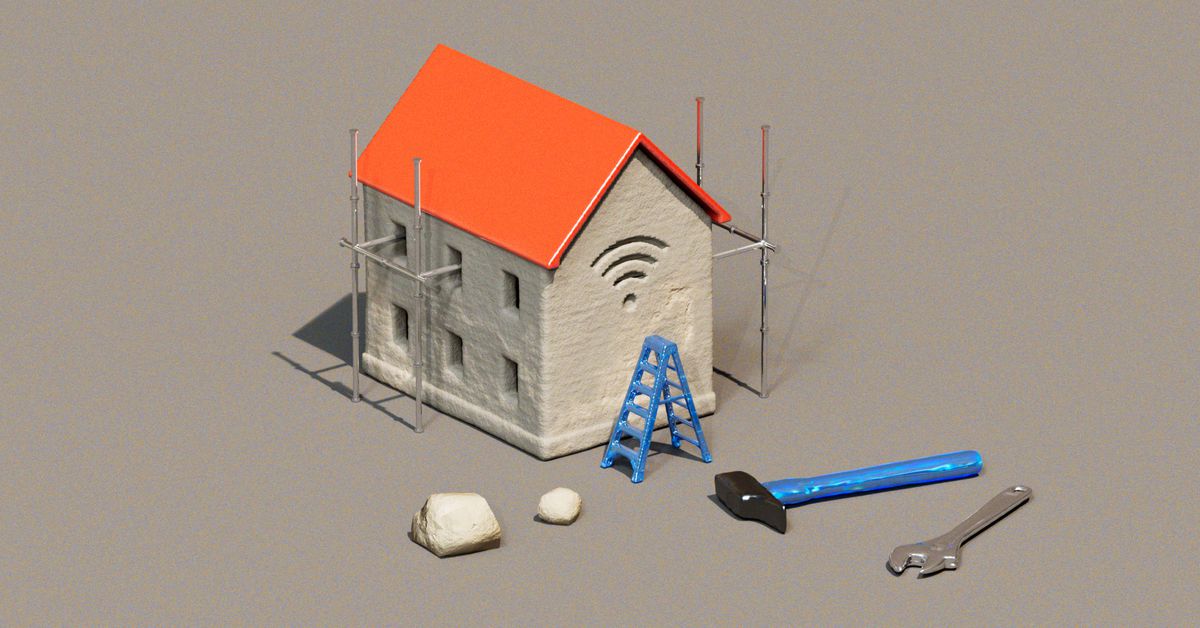If we don’t want our homes to eat Wi-Fi signals, companies will need to start eating the cost of choosing better Wi-Fi-penetrating materials — or, at the very least, they will need to stop putting fiber connection points literally inside walls.
Or you could just USE THE DAMN ETHERNET DROPS THEY SO KINDLY BUILT FOR YOU.
Of course you’re going to get shit signal if you put one AP in a metal box and expect it to cover the whole house. that’s why they built that box and ran Ethernet throughout the house.
Ideally houses would have ceiling drops for Ethernet. Consumers are getting all these wireless mesh networks that cause more problems than they solve.
I put a Ubiquiti long-range Wifi 6 AP on my ceiling, fed with a Dream Machine Pro SE. Google Fiber just kept saying, “You know, we could ‘upgrade’ you to our mesh stuff for free!” Ha, no thanks.
Btw, this is not an endorsement of Google Fiber. I just cancelled it. They can’t or won’t handle chronic infrastructure issues. Multiple outages a day, every day (as confirmed by their app) for weeks to months, and they still wouldn’t even acknowledge that there was a chronic problem, much less tell me any status of a permanent resolution. That service is total trash.
Google Fiber just kept saying, “You know, we could ‘upgrade’ you to our mesh stuff for free!” Ha, no thanks.
You’re much nicer than me. My response would’ve been something like “that shit is a downgrade. Your suggestion is bad, and you should feel bad.” I’m just so fucking sick and tired of assholes trying to upsell me…
I would avoid Google for utilities like the fucking plague. I do not want to pay for terrible customer service on a vital service only for them to cancel it 6 months later.
I did home AV for years and the only consumer mesh system I would ever recommend is Eero. Everything else I used was total shit
Agreed. We requested 2 ceiling drops when building our house (the basement mesh AP is in the network closet on its base). Used PoE to power the 2 mesh APs. Works great for full coverage.
Addendum: Of course, our network box is plastic so it’s wireless transparent. Of If I had to do it again I’d cut the cost of the network box and just use pegboard. Can shut the damn thing anyway with how it’s set up. I’ve got way too many devices to cram in there. Oh well, hindsight and all.
If they’re wired back to a switch, they’re not “mesh” APs. Having a wireless AP-to-AP backhaul connection is what “mesh” is.
Being pedantic are we?
Hell yeah!
Ok, I can play along. Just because they’re not being used in a mesh doesn’t mean they aren’t still mesh APs (because they are). It’s just on the ones I have, I prefer the stability of wired over the speed of the tri-band wireless backhaul. I’m not saturating wired at the speeds I’m using anyway (500/500) with a lot of streaming to different devices.
If we’re making requests, please use conduit for wires. Pulling new cable (cat x, fiber, whatever) is such much easier that way.
I wish I could upvote multiple times: 20 years ago, I sent so much time crawling around the attic and running cable through walls, now I’m looking to upgrade but am not willing to do that again. I really wish I had taken a little more time and run conduit
There’s been an unfortunate trend of newly-built houses not running Ethernet cables. Here in Canada, at least. You can still run them yourself, but the average person probably isn’t going to bother with it.
So if they can’t be bothered, then I’d say it’s not a big deal to them.
Hell, I couldn’t be arsed to run a wire for my TV for months. And I’ve run miles of cable, and it was trivially easy for my TV, took about an hour.
deleted by creator
He says at the end how he “knows this stuff” because he’s a tech journalist.
But he doesn’t know what an Access Point is? Or that those built in wireless routers are dog shit with small antennas and terrible range.
He’s probably the kind of person that would bitch that his backyard doesn’t get wifi from the ISP provided router on the other side of the house.
I try not to shit on articles too much because I understand that the vast majority of writers these days are given a prompt and talking points by their editors but…
I have the privilege of knowing how to troubleshoot this stuff on my own largely due to my profession as a tech journalist. To others, this stuff is a foreign language. Knowing how to set up a home internet system is not a skill everyone has, and the complicated steps required to do it properly make moving to a new place more stressful, especially if you work remotely and need the internet to earn a paycheck.
Clearly setting up a home internet system is also not a skill this tech writer has.
This is a solved problem. It is a mesh network. Yes, you can spend insane amounts of money for a ubiquiti solution (and they are nice…). Or you can wait for a sale on a google/amazon solution. Or you can just look into stuff like the tp-link omada system where your access points are 30-40 bucks and can act as both repeaters and extenders, depending on your setup.
Don’t get me wrong, ethernet is always better. But it really is not necessary in the vast majority of use cases. And considering the cost of building or renovating a house, I would not look into drywall alternatives in addition to adding ethernet drops.
Also, if they think THAT networking panel is a mess then… I very much question if they have ever touched an ethernet cable before. I have seen top of the line data/computing centers which were less neatly cabled than that picture.
The whole premise is nuts. It’s like saying we should move the beach closer to the city, to improve our vacation travel.
Don’t get me wrong, ethernet is always better.
That’s the crazy part that deserves shitting on: this guy has ethernet in every room, yet he’s complaining about (checks notes) not being able to easily use something worse! I mean, just look at this paragraph:
A plethora of architects, civil engineers, and project managers across Orange and Los Angeles counties in California all told me the same thing: Wi-Fi-penetrating materials typically aren’t a consideration unless it’s a large structure like an office building or warehouse; telecom technicians are called in then, but mainly to help with wiring. However, those same people told me they’ve been able to reduce construction costs significantly by wiring residences for ethernet as they are building them.
That “plethora” of experts is right, and the author is just fucking nuts.
I have never been in any residential situation where just parking a bog standard router roughly central to the building, or even just right next to wherever the cable guy punched into the house, was not perfectly adequate for all users and their myriad devices to receive a reliable wi-fi signal. “Wi-fi penetrating” materials or not. This cat is either residing in a McMansion of epic proportions, or he’s overblowing his issues to pad out his word count.
That is not to say that the wiring situation and cabling situation you may inherit will be adequate for tech nerds (myself possibly included) but for the average citizen just tucking your ISP provided router somewhere out of sight is all it takes and is just fine.
You want to talk about headaches? The house I’m living in was built in the 1920’s and it’s all plaster. I have nowhere to run Cat6, other than stapled to the underside of the floorboards from the basement, and surface mount boxes coming up thruogh the floor. For my upstairs runs I have to run it in channel up the rear corners of closets where it’s out of sight, and punch up through the ceiling and the floor above. Pulling cable through the walls is a non-starter; most of the interior walls don’t even have an air gap between what should be the inside faces. Pull that off and you can come back and talk to me about “hurdles.”
My house was built in the 80s. I am not aware of any special materials, but the pipes and wiring in the wall more or less kill all cell signal if you aren’t on the side of the house facing the tower (I forget the term for it, but I have the kind of baseboard heaters that use hot water). And considering a lot of other houses in the neighborhood have the same issue, it rapidly becomes one or two rooms where I have cell reception. Actually means I bother to set up a guest network on my wifi so that people who come over that I don’t trust to have access to my personal network can still receive texts and the like.
In terms of wifi? If I put the wireless access point in the living room, I more or less have signal. But my drop is in the basement (which is awesome for my server room needs) and that means upstairs has a LOT of dead zones.
It really depends on construction, but this is WHY office buildings are designed around this. I just don’t think apartment complexes need to be because you are going to have an ethernet drop in every unit anyway.
I have, everywhere I’ve lived for the last 15+ years.
Plenty of materials in walls to kill signal.
Mesh networks are severely limited in terms of mbps/throughput. They also use their own throughput channel to communicate and sync with each other, further reducing available bandwidth.
They also can introduce a lot of latency and packet loss if you’re into gaming that needs to be taken into consideration.
They have a purpose and a use, but if you want to get the benefits of modern internet speeds, you should set up a wired network and only use wireless protocols for small, difficult to wire, devices.
If there are Ethernet ports in every room (as the article describes) then the back haul happens over wire. No unusual packet loss or latency with a few plug and play pucks throughout the house.
Yeah. Have most just act in mesh mode for the wired internet so that your mobile devices (which are generally latency insensitive) have optimal coverage. If there is a spot that you just can’t reach and that has no drops? That is when you turn on extender mode and start taking the hit.
Also, if there is meaningful packet loss then that is generally a sign that your access points are too far apart. If the signal barely reaches the access point then it can’t really meaningfully extend the reach of the network.
Modern budget mesh hardware will happily pipe gigabit speeds over their backhaul. Plenty fast for most people today.
The article is speaking for the masses, not the technoelite. Modern mesh APs wireless backhauls are plenty fast for them. Even an eero setup would be a vast improvement over the router their ISP gave them.
This was true about older mesh systems, that’s not an issue today, you’ll see you’re ping go up a couple of ms and your mbps go down by 10 less. Speaking from experience, in a house where a single router is leaving some deadzones, mesh networks are leaps and bounds better. You can easily game on them.
I didn’t bother reading it all but seems like the writer is mostly complaining about their personal tech issues and blaming their house, which seems to have an almost ideal setup for building a good network.
Overlooking that is very possible, but I guess I expected more, isn’t The Verge a tech site?
No. They’re literally a meme for how bad they are on tech content: https://knowyourmeme.com/memes/events/the-verges-gaming-pc-build-video
deleted by creator
Guy wants to change the construction industry because he doesn’t know mesh WiFi or many other better solutions exist
Hmm. I just moved into a new house in SoCal, and I’m not having any of the problems he describes. In fact I’d describe the installation of my symmetric 2gbps fiber connection as very clean, and WiFi propagation has been excellent.
I’m not ecstatic that the router they provided is an Amazon eero, but I could replace that myself if I wanted.
unless it’s for privacy reasons eeros are actually pretty good imo
Wait, so this person is irritated about the fact that he’s not getting good signal by stuffing his Wifi router into the wall? Do they not realize they can just use one of those Ethernet lines to place the router in a more open spot? Or even have multiple APs throughout the house?
What a bunch of ignorant, industry shilling, bullshit. If that guys a tech journalist, he should be replaced by ai.
Speaking as someone with an 80 year old house, with really dense materials like concrete, plaster, steel rebar and lathe work, you people in modern homes have no idea how transparent to WiFi your house already is.
Damn that’s a simple structured wiring box. Is that really the best he can do for claiming it’s complex. He needs to offer someone technical a case of beer to spend an hour tidying it up.
WiFi? That’s your idea of “digital infrastructure “ that needs to be modernized. Holy shot there are so many more important things, even if you limit yourself to digital infrastructure
deleted by creator
This is the best summary I could come up with:
But I encountered more obstacles getting it set up than a track and field hurdler, everything from a missing fiber gateway port to my $1,000 robot vacuum losing connection every time it tried to clean too far away from the router.
I was saved by the ethernet ports in every room and my off-the-shelf Asus gaming router, but I couldn’t (and still can’t) do anything about the cable Cthulhu monstrosity lurking behind a metal plate in my closet that drives most of my frustration.
Over the last several years, more engineering and architecture firms have started including ethernet wiring in their building plans, but that’s as far as the digital infrastructure of a home usually goes.
The Information Technology and Innovation Foundation (ITIF) noted in a recent blog post that if the US were to focus a significant chunk of its efforts on creating a better digital infrastructure instead of “fixing” our physical infrastructure, it would result in “superior longer-term economic growth, competitiveness, national security, and environmental benefits.” This includes outfitting buildings and dwellings with wired Gigabit fiber internet and, more importantly, taking into consideration which materials would obstruct Wi-Fi signals the least.
A plethora of architects, civil engineers, and project managers across Orange and Los Angeles counties in California all told me the same thing: Wi-Fi-penetrating materials typically aren’t a consideration unless it’s a large structure like an office building or warehouse; telecom technicians are called in then, but mainly to help with wiring.
With many states in the middle of a severe housing crisis driven in part by those rising material costs, it’s likely many companies will continue to build for speed.
The original article contains 918 words, the summary contains 274 words. Saved 70%. I’m a bot and I’m open source!
No walls can help for wifi strength.













